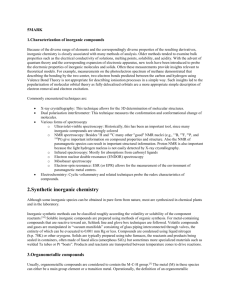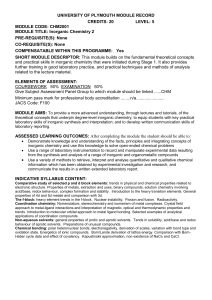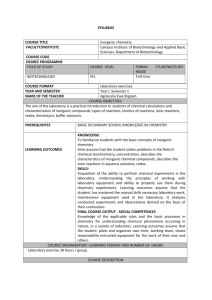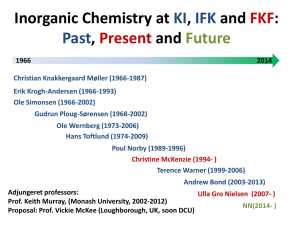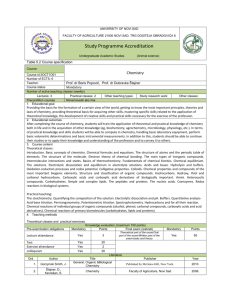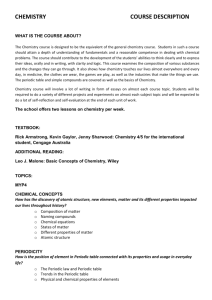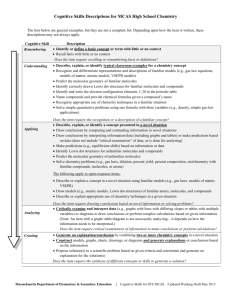inorganic chemistry
advertisement
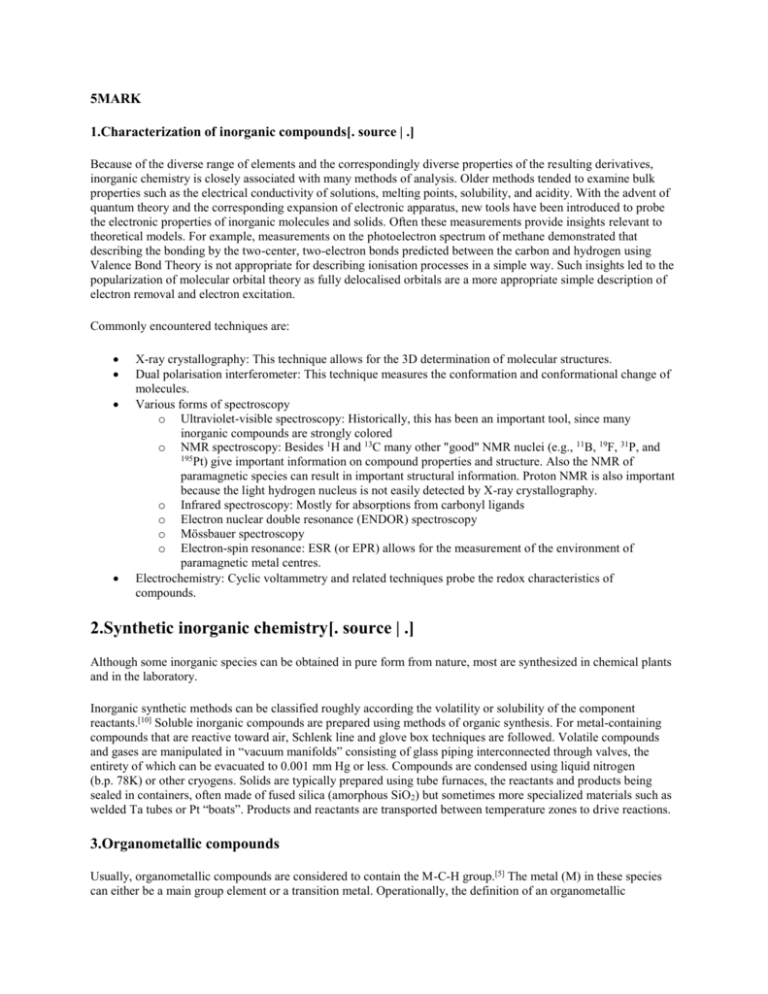
5MARK 1.Characterization of inorganic compounds[. source | .] Because of the diverse range of elements and the correspondingly diverse properties of the resulting derivatives, inorganic chemistry is closely associated with many methods of analysis. Older methods tended to examine bulk properties such as the electrical conductivity of solutions, melting points, solubility, and acidity. With the advent of quantum theory and the corresponding expansion of electronic apparatus, new tools have been introduced to probe the electronic properties of inorganic molecules and solids. Often these measurements provide insights relevant to theoretical models. For example, measurements on the photoelectron spectrum of methane demonstrated that describing the bonding by the two-center, two-electron bonds predicted between the carbon and hydrogen using Valence Bond Theory is not appropriate for describing ionisation processes in a simple way. Such insights led to the popularization of molecular orbital theory as fully delocalised orbitals are a more appropriate simple description of electron removal and electron excitation. Commonly encountered techniques are: X-ray crystallography: This technique allows for the 3D determination of molecular structures. Dual polarisation interferometer: This technique measures the conformation and conformational change of molecules. Various forms of spectroscopy o Ultraviolet-visible spectroscopy: Historically, this has been an important tool, since many inorganic compounds are strongly colored o NMR spectroscopy: Besides 1H and 13C many other "good" NMR nuclei (e.g., 11B, 19F, 31P, and 195 Pt) give important information on compound properties and structure. Also the NMR of paramagnetic species can result in important structural information. Proton NMR is also important because the light hydrogen nucleus is not easily detected by X-ray crystallography. o Infrared spectroscopy: Mostly for absorptions from carbonyl ligands o Electron nuclear double resonance (ENDOR) spectroscopy o Mössbauer spectroscopy o Electron-spin resonance: ESR (or EPR) allows for the measurement of the environment of paramagnetic metal centres. Electrochemistry: Cyclic voltammetry and related techniques probe the redox characteristics of compounds. 2.Synthetic inorganic chemistry[. source | .] Although some inorganic species can be obtained in pure form from nature, most are synthesized in chemical plants and in the laboratory. Inorganic synthetic methods can be classified roughly according the volatility or solubility of the component reactants.[10] Soluble inorganic compounds are prepared using methods of organic synthesis. For metal-containing compounds that are reactive toward air, Schlenk line and glove box techniques are followed. Volatile compounds and gases are manipulated in “vacuum manifolds” consisting of glass piping interconnected through valves, the entirety of which can be evacuated to 0.001 mm Hg or less. Compounds are condensed using liquid nitrogen (b.p. 78K) or other cryogens. Solids are typically prepared using tube furnaces, the reactants and products being sealed in containers, often made of fused silica (amorphous SiO 2) but sometimes more specialized materials such as welded Ta tubes or Pt “boats”. Products and reactants are transported between temperature zones to drive reactions. 3.Organometallic compounds Usually, organometallic compounds are considered to contain the M-C-H group.[5] The metal (M) in these species can either be a main group element or a transition metal. Operationally, the definition of an organometallic compound is more relaxed to include also highly lipophilic complexes such as metal carbonyls and even metal alkoxides. Organometallic compounds are mainly considered a special category because organic ligands are often sensitive to hydrolysis or oxidation, necessitating that organometallic chemistry employs more specialized preparative methods than was traditional in Werner-type complexes. Synthetic methodology, especially the ability to manipulate complexes in solvents of low coordinating power, enabled the exploration of very weakly coordinating ligands such as hydrocarbons, H2, and N2. Because the ligands are petrochemicals in some sense, the area of organometallic chemistry has greatly benefited from its relevance to industry. Examples: Cyclopentadienyliron dicarbonyl dimer (C5H5)Fe(CO)2CH3, Ferrocene Fe(C5H5)2, Molybdenum hexacarbonyl Mo(CO)6, Diborane B2H6, Tetrakis(triphenylphosphine)palladium(0) Pd[P(C6H5)3]4 20MARK 4.Mechanistic inorganic chemistry[. source | .] An important and increasingly popular aspect of inorganic chemistry focuses on reaction pathways. The mechanisms of reactions are discussed differently for different classes of compounds. Main group elements and lanthanides[. source | .] The mechanisms of main group compounds of groups 13-18 are usually discussed in the context of organic chemistry (organic compounds are main group compounds, after all). Elements heavier than C, N, O, and F often form compounds with more electrons than predicted by the octet rule, as explained in the article on hypervalent molecules. The mechanisms of their reactions differ from organic compounds for this reason. Elements lighter than carbon (B, Be, Li) as well as Al and Mg often form electron-deficient structures that are electronically akin to carbocations. Such electron-deficient species tend to react via associative pathways. The chemistry of the lanthanides mirrors many aspects of chemistry seen for aluminium. Transition metal complexes[. source | .] Mechanisms for the reactions of transition metals are discussed differently from main group compounds. [9] The important role of d-orbitals in bonding strongly influences the pathways and rates of ligand substitution and dissociation. These themes are covered in articles on coordination chemistry and ligand. Both associative and dissociative pathways are observed. An overarching aspect of mechanistic transition metal chemistry is the kinetic lability of the complex illustrated by the exchange of free and bound water in the prototypical complexes [M(H 2O)6]n+: [M(H2O)6]n+ + 6 H2O* → [M(H2O*)6]n+ + 6 H2O where H2O* denotes isotopically enriched water, e.g., H217O The rates of water exchange varies by 20 orders of magnitude across the periodic table, with lanthanide complexes at one extreme and Ir(III) species being the slowest. Redox reactions[. source | .] Redox reactions are prevalent for the transition elements. Two classes of redox reaction are considered: atomtransfer reactions, such as oxidative addition/reductive elimination, and electron-transfer. A fundamental redox reaction is "self-exchange", which involves the degenerate reaction between an oxidant and a reductant. For example, permanganate and its one-electron reduced relative manganate exchange one electron: [MnO4]− + [Mn*O4]2− → [MnO4]2− + [Mn*O4]− Reactions at ligands[. source | .] Coordinated ligands display reactivity distinct from the free ligands. For example, the acidity of the ammonia ligands in [Co(NH3)6]3+ is elevated relative to NH3 itself. Alkenes bound to metal cations are reactive toward nucleophiles whereas alkenes normally are not. The large and industrially important area of catalysis hinges on the ability of metals to modify the reactivity of organic ligands. Homogeneous catalysis occurs in solution and heterogeneous catalysis occurs when gaseous or dissolved substrates interact with surfaces of solids. Traditionally homogeneous catalysis is considered part of organometallic chemistry and heterogeneous catalysis is discussed in the context of surface science, a subfield of solid state chemistry. But the basic inorganic chemical principles are the same. Transition metals, almost uniquely, react with small molecules such as CO, H 2, O2, and C2H4. The industrial significance of these feedstocks drives the active area of catalysis. Ligands can also undergo ligand transfer reactions such as transmetalation. 5.Other acid–base theories[. source | .] Lux–Flood definition[. source | .] This acid–base theory was a revival of oxygen theory of acids and bases, proposed by German chemist Hermann Lux[18][19] in 1939, further improved by Håkon Flood circa 1947[20] and is still used in modern geochemistry and electrochemistry of molten salts. This definition describes an acid as an oxide ion (O2− ) acceptor and a base as an oxide ion donor. For example: [21] MgO (base) + CO 2 (acid) → MgCO 3 CaO (base) + SiO 2 (acid) → CaSiO 3 NO− 3 (base) + S 2O2− 7 (acid) → NO+ 2 + 2 SO2− 4 Pearson definition[. source | .] .: HSAB theory In 1963,[22] Ralph Pearson proposed an advanced qualitative concept known as Hard Soft Acid Base principle, later made quantitative with help of Robert Parr in 1984. 'Hard' applies to species that are small, have high charge states, and are weakly polarizable. 'Soft' applies to species that are large, have low charge states and are strongly polarizable. Acids and bases interact, and the most stable interactions are hard–hard and soft–soft. This theory has found use in organic and inorganic chemistry. Usanovich definition[. source | .] Mikhail Usanovich developed a general theory that does not restrict acidity to hydrogen-containing compounds, but his approach, published in 1938, was even more general than Lewis theory. [2] Usanovich's theory can be summarized as defining an acid as anything that accepts negative species or donates positive ones, and a base as the reverse. This defined the concept of redox (oxidation-reduction) as a special case of acid-base reactions Some examples of Usanovich acid-base reactions include: Na 2O (base) + SO 3 (acid) → 2 Na+ + SO2− 4 (species exchanged: anion O 2− ) 3 (NH 4) 2S (base) + Sb 2S 3 (acid) → 6 NH+ 4 + 2 SbS3− 4 (species exchanged: anion S2− ) Na (base) + Cl (acid) → Na+ + Cl− (species exchanged: electron) Acid–alkali reaction[. source | .] .: Neutralization (chemistry) An acid–alkali reaction is a special case of an acid–base reaction, where the base used is also an alkali. When an acid reacts with an alkali it forms a metal salt and water. Acid–alkali reactions are also a type of neutralization reaction. In general, acid–alkali reactions can be simplified to OH− (aq) + H+ (aq) → H 2O by omitting spectator ions. Acids are in general pure substances that contain hydrogen ions (H+ ) or cause them to be produced in solutions. Hydrochloric acid (HCl) and sulfuric acid (H 2SO 4) are common examples. In water, these break apart into ions: HCl → H+ (aq) + Cl− (aq) H 2SO 4 → H+ (aq) + HSO− 4(aq) To produce hydroxide ions in water, the alkali breaks apart into ions as below: NaOH → Na+ (aq) + OH− (aq) 6.Thermodynamics and mechanism[. source | .] Hydrogenation is a strongly exothermic reaction. In the hydrogenation of vegetable oils and fatty acids, for example, the heat released is about 25 kcal per mole (105 kJ/mol), sufficient to raise the temperature of the oil by 1.6–1.7 °C per iodine number drop. The mechanism of metal-catalyzed hydrogenation of alkenes and alkynes has been extensively studied.[14] First of all isotope labeling using deuterium confirms the regiochemistry of the addition: RCH=CH2 + D2 → RCHDCH2D Heterogeneous catalysis[. source | .] On solids, the accepted mechanism is the Horiuti-Polanyi mechanism:[15][16] 1. 2. 3. Binding of the unsaturated bond, and hydrogen dissociation into atomic hydrogen onto the catalyst Addition of one atom of hydrogen; this step is reversible Addition of the second atom; effectively irreversible under hydrogenating conditions. In the second step, the metallointermediate formed is a saturated compound that can rotate and then break down, again detaching the alkene from the catalyst. Consequently, contact with a hydrogenation catalyst necessarily causes cis-trans-isomerization, because the isomerization is thermodynamically favorable. This is a problem in partial hydrogenation, while in complete hydrogenation the produced trans-alkene is eventually hydrogenated. For aromatic substrates, the first bond is hardest to hydrogenate because of the free energy penalty for breaking the aromatic system. The product of this is a cyclohexadiene, which is extremely active and cannot be isolated; in conditions reducing enough to break the aromatization, it is immediately reduced to a cyclohexene. The cyclohexene is ordinarily reduced immediately to a fully saturated cyclohexane, but special modifications to the catalysts (such as the use of the anti-solvent water on ruthenium) can preserve some of the cyclohexene, if that is a desired product. Homogeneous catalysis[. source | .] In many homogeneous hydrogenation processes,[17] the metal binds to both components to give an intermediate alkene-metal(H)2 complex. The general sequence of reactions is assumed to be as follows or a related sequence of steps: binding of the hydrogen to give a dihydride complex ("oxidative addition"): LnM + H2 → LnMH2 binding of alkene: LnM(η2H2) + CH2=CHR → Ln-1MH2(CH2=CHR) + L transfer of one hydrogen atom from the metal to carbon (migratory insertion) Ln-1MH2(CH2=CHR) → Ln-1M(H)(CH2-CH2R) transfer of the second hydrogen atom from the metal to the alkyl group with simultaneous dissociation of the alkane ("reductive elimination") Ln-1M(H)(CH2-CH2R) → Ln-1M + CH3-CH2R Preceding the oxidative addition of H2 is the formation of a dihydrogen complex. 7.Isomerization In chemistry isomerization (also isomerisation) is the process by which one molecule is transformed into another molecule which has exactly the same atoms, but the atoms are rearranged e.g. A-B-C → B-A-C (these related molecules are known as isomers [1]). In some molecules and under some conditions, isomerization occurs spontaneously. Many isomers are equal or roughly equal in bond energy, and so exist in roughly equal amounts, provided that they can interconvert relatively freely, that is the energy barrier between the two isomers is not too high. When the isomerization occurs intramolecularly it is considered a rearrangement reaction. An example of an organometallic isomerization is the production of decaphenylferrocene, [(η5-C5Ph5)2Fe] from its linkage isomer.[2][3] Instances of isomerization[. source | .] Isomerizations in hydrocarbon cracking is usually employed in organic chemistry, where fuels, such as pentane, a straight-chain isomer, are heated in the presence of a platinum catalyst. The resulting mixture of straight- and branched-chain isomers then have to be separated. An industrial process is also the isomerisation of n-butane into isobutane. "Trans-cis isomerism" is where in certain compounds an interconversion of cis and trans isomers can be observed, for instance, with maleic acid and with azobenzene often by photoisomerization. Another example is the photochemical conversion of the trans isomer to the cis isomer of resveratrol:[4] Other instances are Aldose-ketose isomerism in biochemistry; isomerizations between conformational isomers, which take place without an actual rearrangement for instance inconversion of two cyclohexane conformations; fluxional molecules which display rapid interconversion of isomers e.g. bullvalene; and "valence isomerization": the isomerization of molecules which involve structural changes resulting only from a relocation of single and double bonds. If a dynamic equilibrium is established between the two isomers it is also referred to as valence tautomerism [5] The energy difference between two isomers is called "isomerization energy". Isomerizations with low energy difference both experimental and computational (in parentheses) are endothermic trans-cis isomerization of 2-butene with 2.6 (1.2) kcal/mol, cracking of isopentane to n-pentane with 3.6 (4.0) kcal/mol or conversion of trans-2-butene to 1-butene with 2.6 (2.4) kcal/mol.[6]
